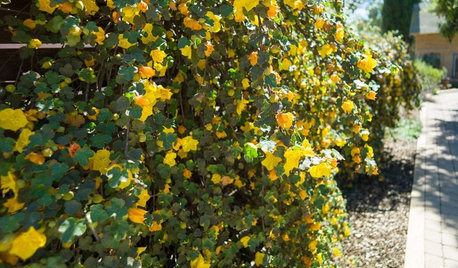where do I prune these trees?
thecityman, Zone 7a/6b near Nashville
10 years ago
Related Stories

GARDENING GUIDESTidy Up Sprawling Native Shrubs With These Pruning Tips
Sound horticultural pruning methods work for native and nonnative plants alike
Full Story
WINTER GARDENINGPruning Secrets for Exquisite Roses
Encourage gorgeous blooms year after year with this time-tested advice on how to prune your rosebush in winter for health and shape
Full Story
GARDENING GUIDESHow to Prune Your Flowering Shrubs for the Best Blooms
Less is often more when it comes to properly pruning flowering shrubs. Here’s what to do and why
Full Story
GARDENING GUIDESGot Frost-Damaged Plants? How It Happens, and When and How to Prune
Crispy brown leaves are a sure sign that Jack Frost has been to your neighborhood
Full Story
HOMES AROUND THE WORLDMy Houzz: Where Palm Springs Meets Gum Trees
A love of midcentury design and a knack for renovating lead this family to a 1960s gem on the outskirts of Melbourne
Full Story
REMODELING GUIDESWhere to Splurge, Where to Save in Your Remodel
Learn how to balance your budget and set priorities to get the home features you want with the least compromise
Full Story
EXTERIORSWhere Front Yards Collide: Property Lines in Pictures
Some could be twins; others channel the Odd Couple. You may never look at property boundaries the same way again
Full Story
GARDENING GUIDESGreat Design Tree: Australian Tea Tree
A living sculpture with an unmistakable appearance, this coastal native creates an intriguing landscape scene
Full Story
GARDENING GUIDESHow to Keep Your Trees Healthy
Ensure your trees’ vigor for years to come with these tips for protecting roots, watering effectively and more
Full Story








alan haigh
drew51 SE MI Z5b/6a
Related Professionals
Wrentham Landscape Architects & Landscape Designers · Forest Park Landscape Architects & Landscape Designers · Mooresville Landscape Contractors · Arlington Landscape Contractors · Barrington Landscape Contractors · Clayton Landscape Contractors · Deer Park Landscape Contractors · East Chicago Landscape Contractors · Fair Oaks Landscape Contractors · Fort Worth Landscape Contractors · Raleigh Landscape Contractors · Rosemount Landscape Contractors · Secaucus Landscape Contractors · Thornton Landscape Contractors · Gulf Gate Estates Tree Servicesthecityman, Zone 7a/6b near NashvilleOriginal Author
drew51 SE MI Z5b/6a
alan haigh
thecityman, Zone 7a/6b near NashvilleOriginal Author